The global chatbot market is going to reach $15.4 billion by 2030. Hundreds of companies worldwide develop various types of chatbots that focus on improving their clients’ experience and decreasing customer service costs. A “big market pie” motivates companies to develop new solutions. However, some of these are fairly outdated to serve actual business needs in 2023.
This article will help you understand the different types of chatbots, what these are used for, and what type of chatbot software could have the biggest value for your business.
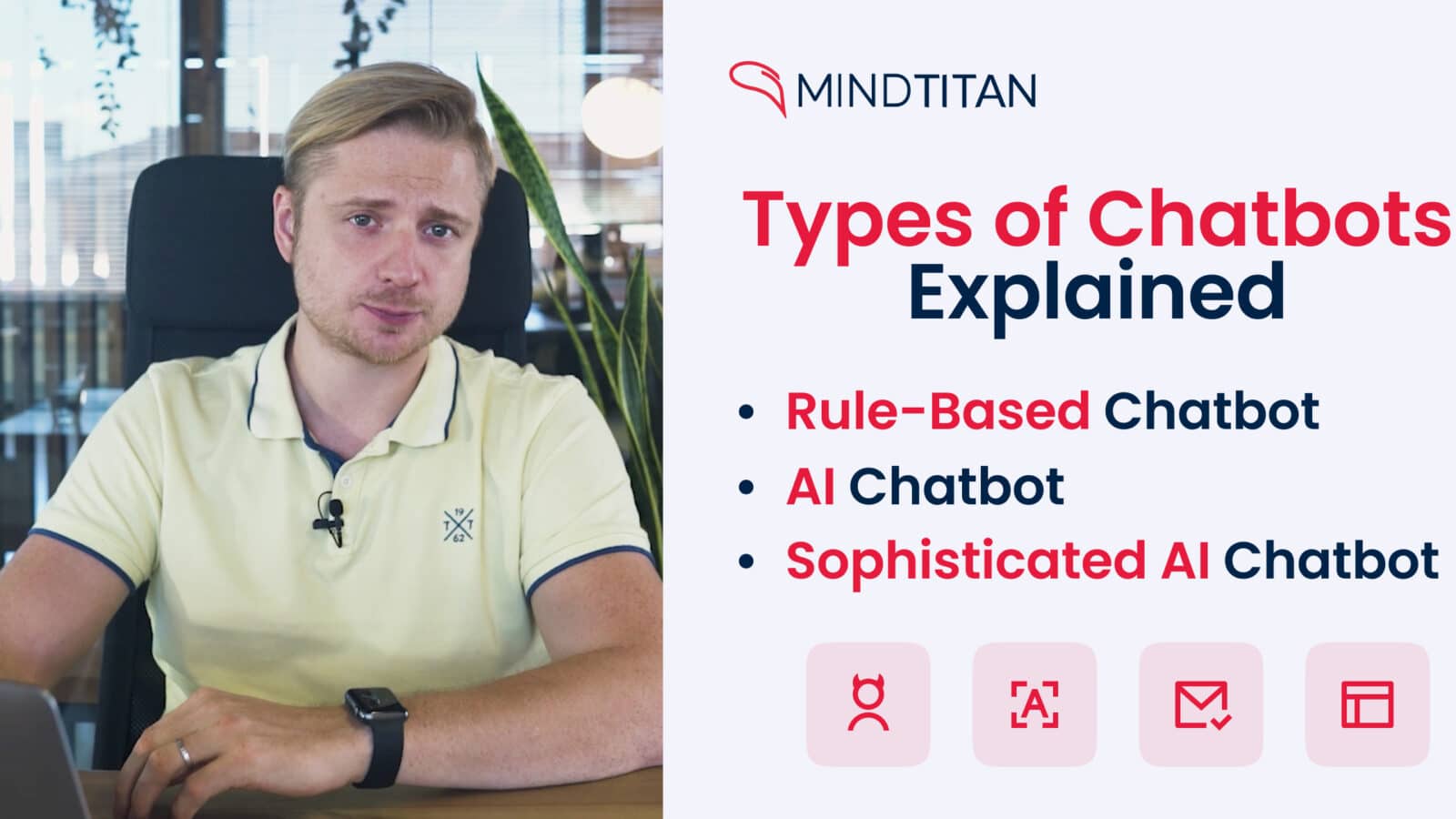
Chatbots Overview
Not all chatbots are the same, and selecting the right one hinges on your needs. Here’s a concise guide to the various types of chatbots available:
-
Rule-based chatbots
These bots operate on a fixed script using if-this-then-that logic, ensuring efficient handling of basic tasks such as answering FAQs or initiating conversations with potential leads. Their ability to deliver quick and straightforward responses is a reassuring feature.
-
Keyword recognition-based chatbots
These AI-driven bots focus on identifying critical phrases within user queries, ensuring precise and relevant assistance. They excel at picking up on details like password reset requests, instilling confidence in their precision.
-
Menu-based chatbots
Similar to navigating a phone menu, these bots present users with a list of options. They are handy for guiding users through specific areas, making them ideal for online shopping scenarios.
-
Contextual chatbots
These sophisticated AI chatbots remember previous interactions and customize their responses accordingly. They improve over time, offering personalized advice based on user behavior, like a banking bot that gives tailored financial tips.
-
Hybrid chatbots
These bots blend the reliability of rule-based logic with the adaptability of AI, ensuring they can handle both simple and complex tasks. Their versatility caters to businesses that require both straightforward answers and personalized suggestions, instilling confidence in their adaptability.
-
Voice chatbots
For those who prefer vocal interaction, voice chatbots offer a natural, hands-free user experience. Voice assistants typically use text-to-speech (TTS) technology. This technology converts written text into spoken words, allowing the chatbot to communicate with users verbally. This technology is essential for enabling voice chatbots to deliver responses in a natural, human-like manner. It works with speech recognition technology, allowing the chatbot to understand and process spoken user inputs, creating a seamless voice interaction experience. Perfect for tasks like controlling smart home devices or getting news updates, these bots elevate convenience to a new level.
Rule-based chatbots vs Artificial intelligence chatbots
Rule-based chatbots became very popular after Facebook launched its Messenger platform where chatbots performed automated customer support for businesses. They are also called “button-based” or “menu-based” chatbots (usually seen in automated phone menus).
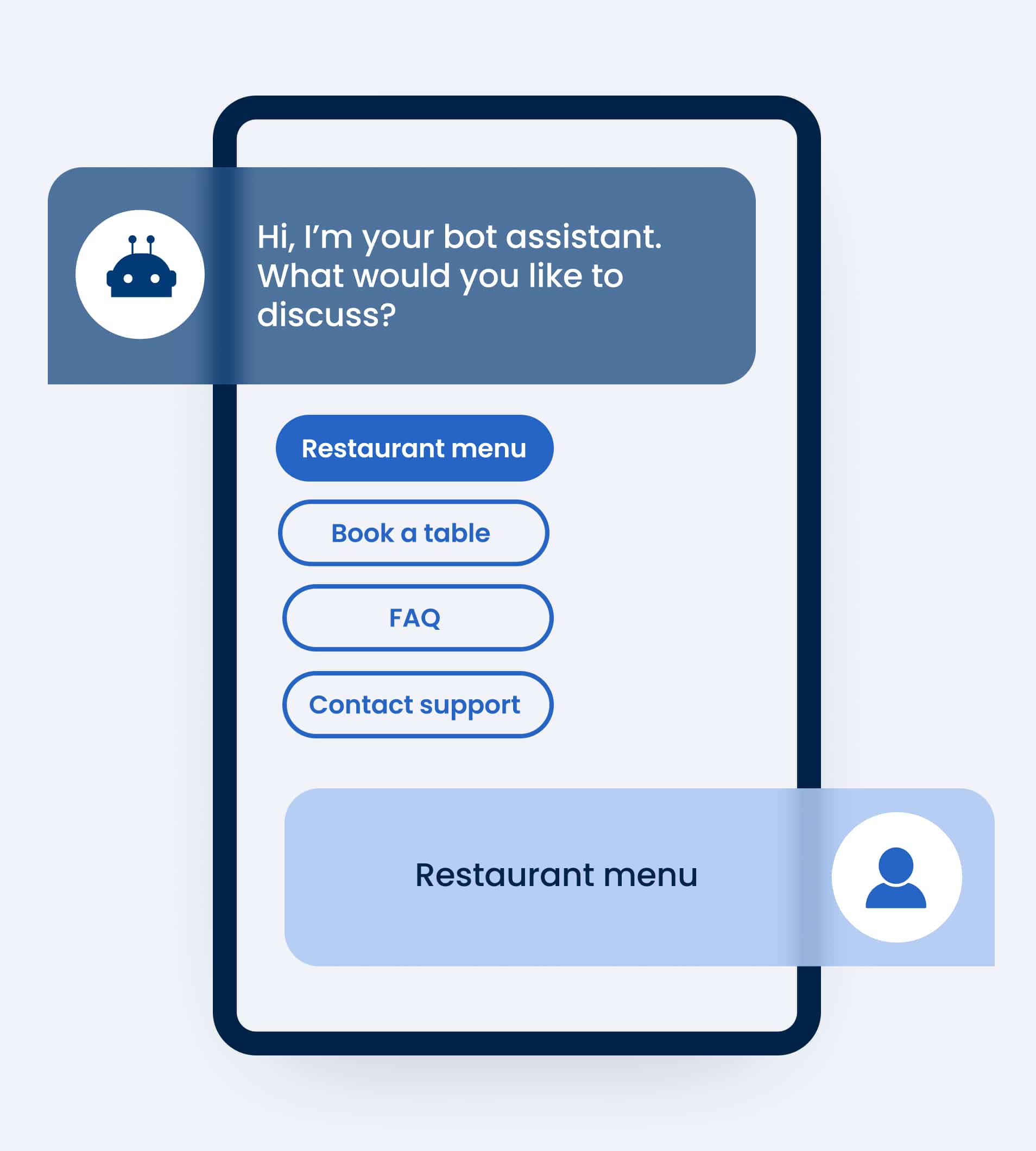
Such types of chatbots are used to answer questions that are often simple – for instance, booking a table in a restaurant, buying tickets to the cinema, or using online delivery services. Guided by a decision tree, the customer is given a set of pre-defined options that lead to the appropriate answer.

These chatbot types are often split into two tracks: a sales track for capturing contact details and setting up a call or a meeting; and a support track for giving generic answers or sending a website link containing the necessary information. In most cases, these types of chatbots are built with graphical or conversational interfaces reacting to the user pressing the chatbot’s menu buttons, which activates the next layer of the decision tree. Sometimes, these types of chatbots are also keyword-based (or have keyword recognition functionality), reacting to specific terms, but these are limited to typos and may not provide appropriate responses, which can cause very frustrating customer experiences.
In general, these are simple chatbots that highly depend on user input. If customer queries fall outside the pre-defined rules, these chatbots fall short of recognizing conversation context and won’t be able to identify advanced scenarios.
How AI Chatbot is different
Artificial intelligence (or machine learning) chatbots, on the other hand, use natural language processing (NLP) technologies to understand the intent behind the question and solve the customer’s problem without any human assistance.
The biggest difference between AI powered chatbots and rule-based chatbots is the usage of machine learning models that significantly increase the bot’s functionality as it can identify hundreds of different questions written by a human, leading to more insightful and dynamic thinking.
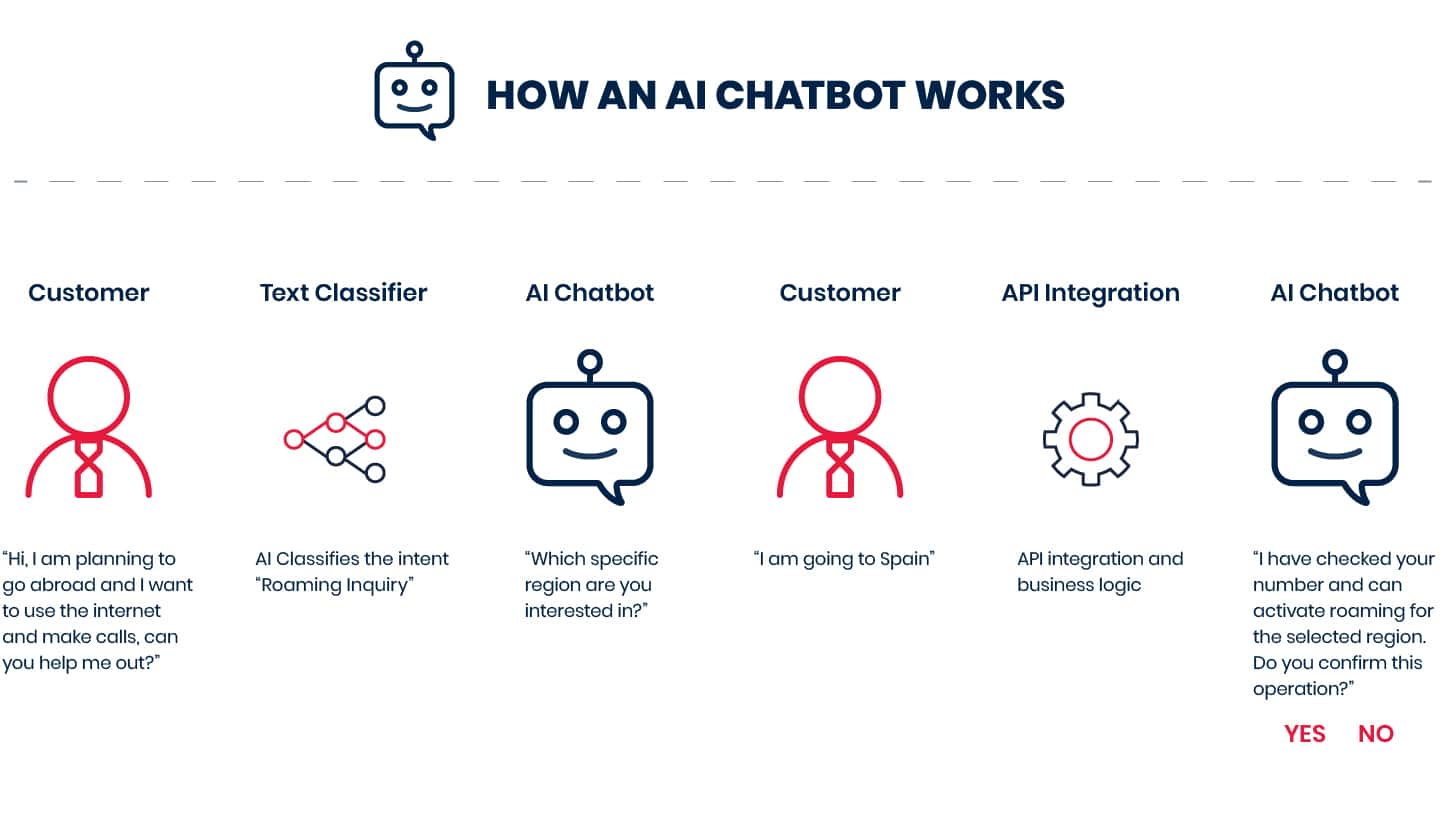
The next step involves creating a sequence of additional questions and answers using the solution flow that helps to specify the exact issue the customer wants to be solved and how it will be done. Aside from that, API integration with the back-end systems allows the bot to perform the task for the customer instead of just providing a link to self-service instructions.
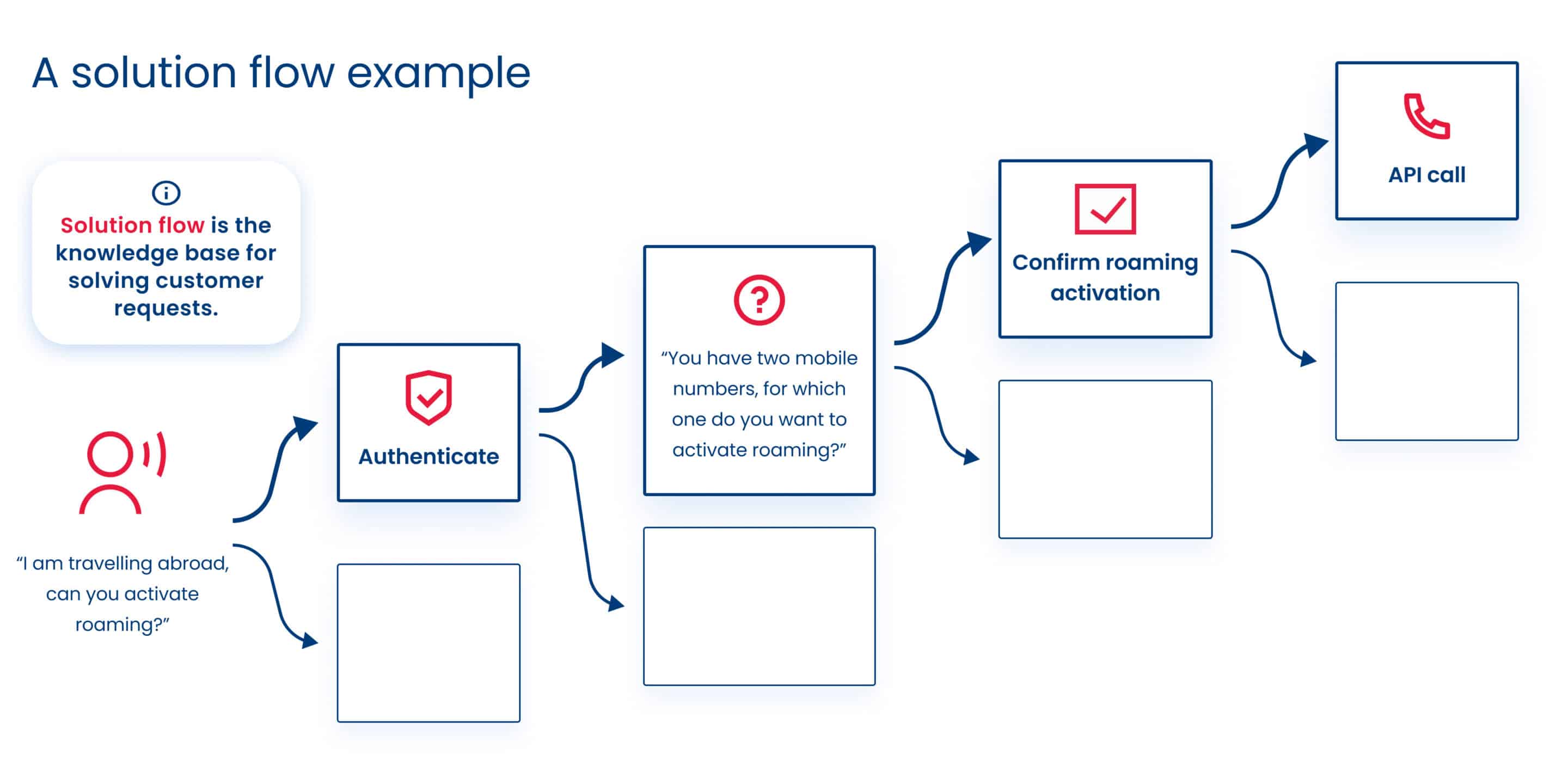
Natural language processing models help an AI-powered chatbot to identify hundreds of different questions, making it very useful for big enterprises in public sectors and private segments like telecommunications, e-commerce, real estate, banking, and insurance, as it can serve thousands of customers automatically, perform complicated tasks on its own, and recognize more advanced scenarios. All of these lead to an improved user experience.
If you are curious about chatbot technology or how chatbots work, you can read our comprehensive article that covers this topic.
Are NLP-based AI Chatbots better than keyword/rule-based ones?
It is incorrect to say that rule-based chatbots are worse; they are just different.
- Learning curve: Rule-based chatbots operate on a fixed set of rules and do not learn from interactions. Conversely, machine learning chatbots continuously improve and become smarter with each conversation.
- Response flexibility: For predictable questions, rule-based chatbots are ideal. However, if you need a bot that can handle unexpected questions, smart chatbots are better equipped to understand and process a wider variety of queries.
- Conversational flow: Interacting with rule-based bots can feel stiff and one-sided. AI powered chatbots strive for a more natural interaction, making conversations feel more human-like.
- Handling complexity: Rule-based chatbots are suitable for simple Q&A tasks. For more complex inquiries requiring adaptive thinking, automated chat agents are more effective.
- Integration capabilities: Rule-based chatbots are compatible with a limited range of tools. AI-enhanced chatbots, on the other hand, can integrate with a wide array of systems and databases, offering more versatility.
- Scalability: Scaling or updating a rule-based chatbot requires manual adjustments. Intelligent chatbots, however, adapt and learn automatically, making them more suitable for evolving needs.
- User experience: Rule-based chatbots provide consistent responses. If you prefer a more personalized experience that evolves based on previous interactions, AI chatbots are the better choice.
- Maintenance: Maintaining a rule-based chatbot involves regular manual updates. In contrast, smart chatbots learn and update themselves over time, reducing the need for constant manual upkeep.
Rule-based chatbots are much simpler, have a specific usage/target user base, and are more affordable. AI powered chatbots, in contrast, are used for more complicated cases to fully resolve customers’ issues. Also, rule-based bots are limited by typos or wrong keywords that people might use. This is why rule-based chatbots require more data for automated customer care service training.
Another problem with rule-based chatbots is that there are limited questions that such bots can handle because they use decision trees. This means bots have a limited number of questions that a client can navigate through. Clients can get lost when it comes to more complicated services than just ordering a pizza.
And, finally, NLP technology has become easily accessible for every company regardless of size. This is why further in this article, we are going to discuss the business value of various machine learning, NLP chatbots.
The business value of different types of AI chatbots
AI chatbots have higher value, as they can automate a larger number of questions, require less data for training (per question), and can solve more complicated issues than rule-based chatbots. However, the AI bot also has different implications, depending on the use case complexity.
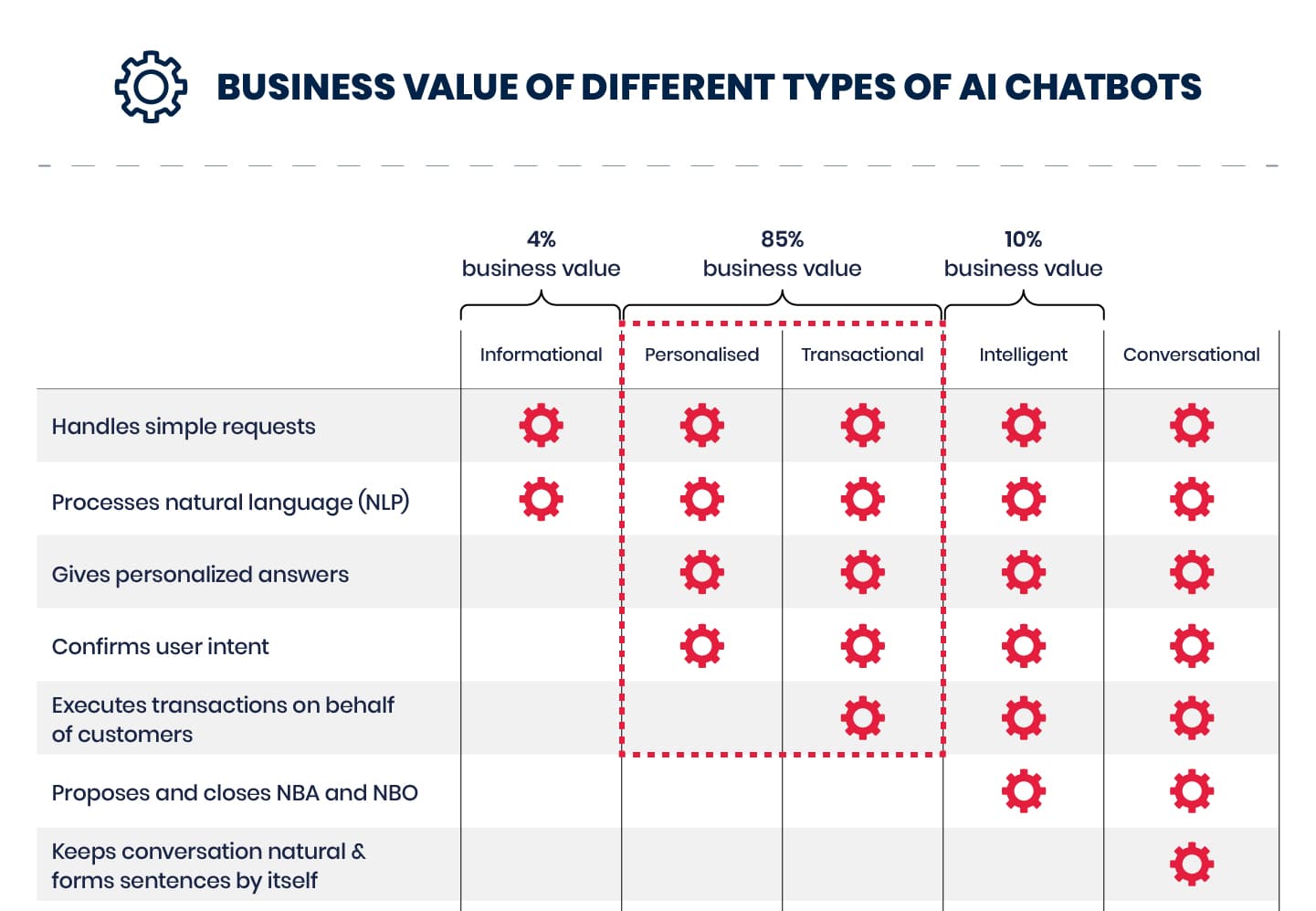
The given illustration is based on the actual experience of one of our biggest telco clients in the Nordics – Elisa, that shared their ideas in the chatbot case example and compared the first contact resolution rate (FCR) in different project stages. From their experience, a basic bot that uses natural language processing and handles simple requests provides only 4% of the total business value that an AI version can provide in maximum.
The basic type of AI bot understands the meaning behind the questions, answers simple ones, and sends informational messages – for example, a link to the FAQ section on the website. The regular chatbot on the example below illustrates how a basic AI chatbot behaves.
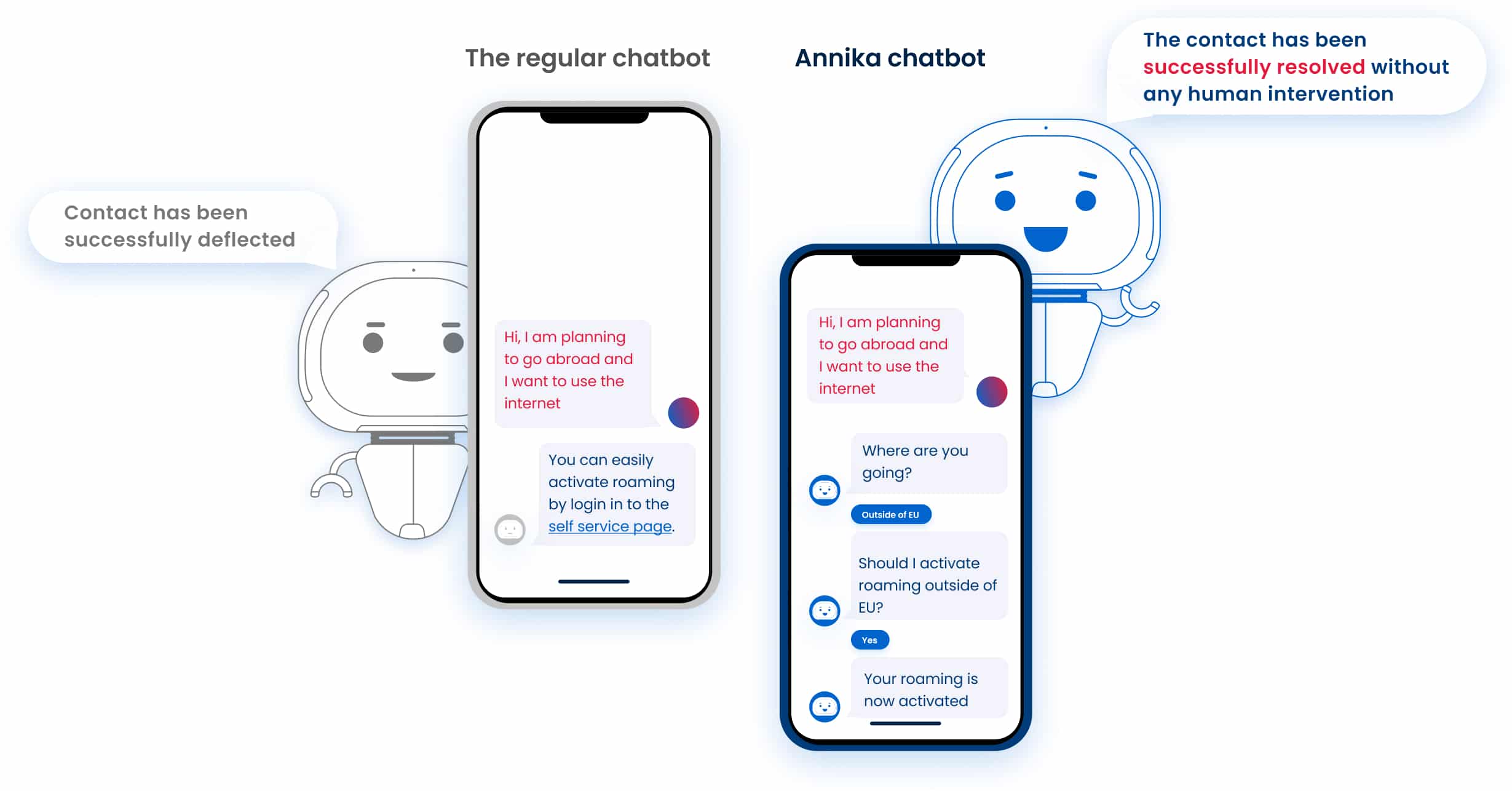
In contrast, Elisa’s transactional chatbot Annika efficiently handles even very complicated cases and fully resolves them without any human intervention.
The biggest business value comes from personalized and transactional types of chatbots that can customize messages and automatically perform the customer’s tasks. Customer verification and API integration with knowledge bases allow the bot to see the client’s historical data and better understand their specific problem. Thus, the bot’s response is personalized, and it can even perform a task for the client, e.g., activate roaming.
Also, using improved NLP algorithms allows the bot to reach 92% text classification accuracy (e.g., the bot classifies correctly 9 out of 10 client questions that the bot has been trained to understand) by confirming the intent with the customer. If a customer asks a question and the bot does not have a high enough confidence level to predict the client’s intent, the bot asks a specifying question, e.g., “Would you like to change billing information or personal information?”
Several additional AI models can be integrated into a chatbot so that it makes the bot much more powerful and intelligent. Through features like the next-best-offer (NBO), chatbots provide users product recommendations based on the customer’s previous interactions with products or services and user profiling based on similar customer segments or behavior on the website. Through this feature, a smart AI model gives an additional 10% of business value.
The last step is the implementation of conversational ai. From our experience, this influences business value the least, as companies are not ready to pay extra for a feature that customers simply do not need. Clients do not value a natural and friendly conversation with bots that support queries; they simply want their problems solved as soon as possible.
How to choose the best chatbot for your business objectives?
Choosing the right chatbot for your business goes beyond technical specs—it’s about finding a digital partner that fits smoothly into your operations and grows with you. Here’s a simple guide to help you pick the best one:
-
Define Your Purpose
Know exactly why you need a chatbot. Is it for boosting sales, improving customer service, or both? Make sure the chatbot can handle these tasks.
-
Ease of Integration
Pick a chatbot that works well with your current systems without causing issues.
-
Smart and Learning
Choose a chatbot with AI and machine learning to improve over time and better serve your customers.
-
Human interaction
Ensure the chatbot uses NLP and understands and responds like a human for more natural conversations.
-
Multilingual Support
If you have international customers, the chatbot should handle multiple languages.
-
Customization
The chatbot should match your brand’s tone and style, making it a seamless part of your team.
-
Scalability
Make sure the chatbot can handle more interactions as your business grows.
-
Security
Prioritize chatbots with strong data protection to keep customer information safe.
-
Analytics
Look for a chatbot with analytics to gain insights into customer needs and improve your service.
-
Cost-Effectiveness
Ensure the chatbot fits your budget, considering all costs from setup to maintenance.
-
Reliable Support
Choose a provider known for excellent support and reliability.
-
User-Friendly
The chatbot should be easy and enjoyable for customers to use.
-
Trial Option
If possible, test the chatbot before committing to see if it fits your needs.
Following these steps will help you find a chatbot that’s not just a tool but a valuable part of your customer support team.
Conclusion
According to Business Insider, nearly 40% of global Internet users prefer chatbots over humans in customer service. This trend is in line with the habit of instantly finding information by just Googling it. When it comes to customer service, people have the same expectations. As technology continues to enable smart AI-enhanced chatbots, more users will choose to interact with them in their everyday lives because the right chatbot knows how to respond appropriately to their concerns on time. For customer service firms, this means improved customer relationships.
This article aimed to help understand the two main out of different types of chatbots: rule-based and AI chatbots. The latter has a much more complicated functionality and contextual awareness that require less training data and that can actually perform the task for the customer without any human assistance. Also, there are different ways to implement the AI bot, depending on the use cases. Hopefully, you now know enough through this chatbot guide and are ready to implement one of the bots in your own business.
Book a Demo with us to learn more about building chatbots and our AI chatbot software.

